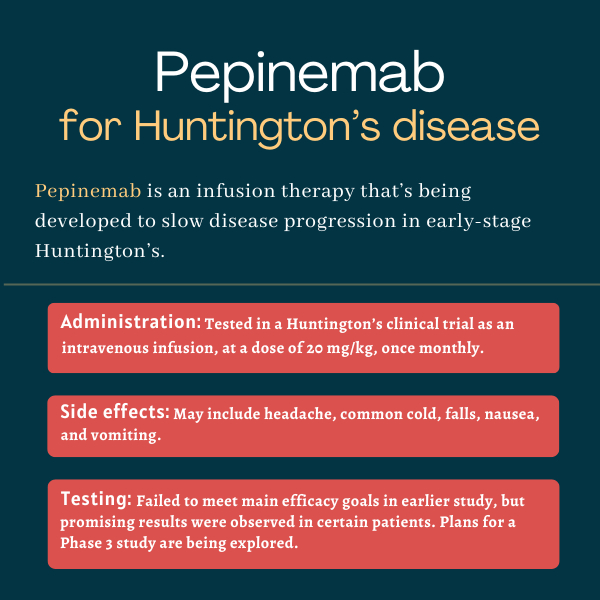
Pepinemab for Huntington’s disease
Last updated Dec. 11, 2024, by Andrea Lobo, PhD

What is pepinemab for Huntington’s disease?
Pepinemab, also known as VX15/2503, is an antibody-based therapy being developed by Vaccinex for Huntington’s disease.
Given via intravenous, or into-the-vein, infusions, the treatment is designed to slow Huntington’s progression by blocking a key driver of neuroinflammation that’s implicated in the neurodegenerative disease.
Pepinemab has received both fast track and orphan drug designations in the U.S. for the treatment of Huntington’s disease. Both statuses provide regulatory support and financial benefits to accelerate a therapy’s clinical development and regulatory review.
Vaccinex is also testing the treatment for Alzheimer’s disease, another neurodegenerative condition, and several types of cancer.
Therapy snapshot
| Treatment name: | Pepinemab |
| Administration: | Being tested in Huntington’s as an intravenous infusion |
| Clinical testing: | Completed a Phase 2 clinical trial; potential Phase 3 development being explored |
How does pepinemab work in Huntington’s disease?
A neurodegenerative disease, Huntington’s is caused by mutations in the HTT gene that result in the production of an abnormally longer huntingtin protein, which forms toxic clumps inside nerve cells, or neurons. Huntington’s is characterized by symptoms such as uncontrolled movements, and cognitive, behavioral, and psychiatric problems.
Pepinemab is a monoclonal antibody designed to block the activity of semaphorin 4D (SEMA4D), a protein implicated in neuroinflammation and neurodegeneration in Huntington’s and other neurodegenerative diseases.
SEMA4D plays key roles in the maturation and activity of glia cells, a group of brain cells that includes immune microglia cells, neuron-supporting astrocytes, and myelin-producing oligodendrocytes. Myelin is the protective coating around nerve fibers that helps neurons send electric signals between them more efficiently.
Stressed or damaged neurons increase the production of SEMA4D, which activates glial cells and promotes neuroinflammation, disrupts the normal function of astrocytes, and suppresses the maturation of oligodendrocytes and myelin repair, or remyelination.
By blocking SEMA4D, pepinemab is therefore expected to prevent microglia activation and the loss of astrocytes’ normal functions, while also promoting remyelination. All these varied effects may help to slow neurodegeneration in Huntington’s, according to Vaccinex.
In animal models of Huntington’s, pepinemab was shown to protect against brain volume loss — a hallmark of the disease — prevent cognitive deficits, and reduce anxiety-like behaviors.
How will pepinemab be administered in Huntington’s disease?
In the single trial that’s tested pepinemab in Huntington’s patients to date, the therapy was administered once a month, through intravenous infusions, at a dose of 20 mg/kg.
Pepinemab in Huntington’s disease clinical trials
The safety, tolerability, and efficacy of pepinemab at the 20 mg/kg dose were evaluated in Huntington’s patients within the placebo-controlled Phase 2 SIGNAL-HD clinical trial (NCT02481674).
The study, launched in 2015, enrolled 301 adults with prodromal Huntington’s — meaning before the onset of disease-specific motor symptoms — or early-stage disease. Participants were ages 21 or older, and the trial was conducted at more than 30 sites in the U.S. and Canada.
There were two patient groups. Group A comprised 36 participants who were randomly assigned to receive either pepinemab or a placebo, once monthly for six months. After that, all received the treatment for an additional six months, and were followed for three months.
This group was used to determine the required number of patients and the treatment duration for Group B, which was composed of 265 participants. Among them, 86 had late prodromal disease and 179 had early disease. These patients were randomly assigned to receive either pepinemab or a placebo, once monthly for 18 months, or about 1.5 years, after which they were followed for three months.
SIGNAL-HD’s main goals were to assess the treatment’s safety and tolerability, as well as changes in the two-item cognitive family and the physician-rated Clinical Global Impression of Change (CGIC) among Group B patients with early-stage disease.
The two-item cognitive family comprises two of the six standardized tests of the Huntington’s Disease Cognitive Assessment Battery (HD-CAB) Composite Index: the paced tapping (PTAP) and one touch stockings (OTS). The PTAP evaluates psychomotor speed and coordination, while the OTS assesses cognitive processes involved in spatial planning and working memory. Specifically, that test assessed patients’ ability to keep information active in the mind for a short period to be processed.
Secondary and exploratory goals were changes in brain volume, as assessed with MRI scans, brain metabolic activity, as determined by FDG-positron emission tomography scans, and motor and cognitive measures, including the six-item HD-CAB Composite Index.
Group A data showed the treatment was generally well-tolerated, without concerning safety signals. Also, pepinemab treatment protected against brain volume loss, or atrophy, significantly increased brain metabolism in seven brain regions of interest, and improved motor and cognitive function relative to a placebo.
The results from Group B early Huntington’s patients indicated the therapy was associated with better scores in the two-item cognitive family and CGIC, as compared with the placebo. Those group differences did not reach statistical significance, however, meaning the study failed to meet its main efficacy goals.
Changes in motor function measures between the pepinemab and placebo groups also did not reach statistical significance.
However, pepinemab treatment led to significantly greater cognitive improvements, as assessed with the HD-CAB Composite Index, in this group of patients. These benefits were most evident among those with early signs of cognitive deficits.
The therapy was also found to significantly reduce, by 26%, shrinkage of the caudate — a part of the brain that is strongly affected by Huntington’s — and prevent or reverse the loss of brain metabolic activity in early disease patients, compared with a placebo.
No significant benefits were seen with pepinemab in Group B’s patients with late prodromal Huntington’s.
Analyses performed after the trial was completed showed that a significantly smaller proportion of pepinemab-treated early Huntington’s patients experienced worse apathy relative to those on a placebo (23% vs. 40%). Apathy is a behavioral symptom of Huntington’s that has been linked to cognitive declines.
In addition, significantly fewer pepinemab-treated patients with more advanced disease at the study’s start experienced disease worsening than those in the placebo group, based on the physician-rated CGIC.
Vaccinex believes these results highlight pepinemab’s potential benefits in people with early Huntington’s. The company now is exploring the possibility of testing the therapy in a larger Phase 3 trial.

Common side effects of pepinemab
In the completed Phase 2 SIGNAL-HD trial, the therapy was reported to be generally safe and well tolerated. The most commonly reported adverse events in patients treated with pepinemab, and at higher rates relative to the placebo group, included headache, common cold, falls, nausea, and vomiting.
The developer has indicated that larger trials are needed to offer a better picture of pepinemab’s side effect profile in people with Huntington’s.
Huntington’s Disease News is strictly a news and information website about the disease. It does not provide medical advice, diagnosis or treatment. This content is not intended to be a substitute for professional medical advice, diagnosis, or treatment. Always seek the advice of your physician or other qualified health provider with any questions you may have regarding a medical condition. Never disregard professional medical advice or delay in seeking it because of something you have read on this website.
Recent Posts
- Faulty cellular waste disposal system may drive Huntington’s: Study
- What the holidays mean when living with Huntington’s disease
- $12M grant will back first trial of stem cell therapy for Huntington’s
- A tribute to the kindness of strangers in life with Huntington’s
- How to support someone who is planning for future care
- Antipsychotics improve functional capacity, independence in HD
- Despite dwindling resources, hope endures among researchers
- The ‘invisible’ symptoms of Huntington’s that people don’t see
- Genetic variant delays Huntington’s onset by up to 23 years: Study
- Watching Huntington’s switch roles in our marriage was jarring



